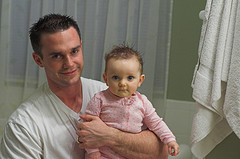
 In April of this year, we told you about the Campaign for Safe Cosmetics study which revealed that nearly two-thirds of the children’s bath products tested (shampoos, lotions, bath soaps) were contaminated with formaldehyde and 1-4 dioxane, both linked to skin allergies and considered potential carcinogens by the Environmental Protection Agency (EPA). Because these ingredients tend to be by-products of manufacturing, they are not added intentionally, and therefore don’t show up on product ingredient lists.
In April of this year, we told you about the Campaign for Safe Cosmetics study which revealed that nearly two-thirds of the children’s bath products tested (shampoos, lotions, bath soaps) were contaminated with formaldehyde and 1-4 dioxane, both linked to skin allergies and considered potential carcinogens by the Environmental Protection Agency (EPA). Because these ingredients tend to be by-products of manufacturing, they are not added intentionally, and therefore don’t show up on product ingredient lists.
Another dangerous chemical that’s in children’s products: pthalates. This particular toxin is especially harmful to the sexual development of young boys, so much so that there is now a “pthalate syndrome”-a condition in which the developing fetus experiences reproductive abnormalities, and may be born with undescended testes and a lower sperm count, and perhaps be at greater risk for tumors in the testes later in life. The Environmental Working Group (EWG) found phthalates in three-quarters of the 72 name-brand products tested.
Such toxins as these are dangerous to everybody, but particularly to children. Their systems are more vulnerable, since they are just developing. Their cells are multiplying at a more rapid rate, their metabolic rates are higher, and they may retain more toxins per exposure because their immune systems are not yet as adept at weeding out the “bad” stuff. Is it simply coincidence that childhood asthma, autism, diabetes, and cancer are increasing at an alarming rate?
What can you do to protect your child? First of all, cut back on the amount of products you use. When you consider that shampoos, conditioners, body washes, lotions, toothpastes, hair sprays, sunscreens, and more are applied every day, you can see how toxins can build up in little bodies. “The main thing parents can do is use fewer body care products on their children or look for those products with fewer ingredients,” says Sonya Lunder, MPH, of CSC and the Environmental Working Group (EWG).
Next, the EWG’s Cosmetic Database advises you to read product labels, and avoid any that contain these seven ingredients:
- 2-Bromo-2-Nitropropane-1,3 Diol
- BHA
- Boric acid and sodium borate
- Dibutyl phthalate & toluene
- DMDM Hydantoin
- Oxybenzone
- Triclosan
While you’re reading labels, try to stay away from other things like synthetic fragrances (choose natural-based fragrances instead, such as those from essential oils), synthetic dyes (colors), benzyl and isopropyl alcohols, ceteareth and PEG compounds, and parabens (preservatives). Finally, avoid the use of baby powder on infants, as it’s been shown to contain phthalates.
Some safer products you may want to try:
- Burt’s Bees, California Baby, and Jason Natural shampoos and conditioners
- California Baby body washes & liquid soaps
- Blue Lizard and California Baby sunscreens
- Seventh Generation baby wipes
To increase your child’s risk of living with fewer toxins, don’t stop with personal-care products. Buy organic produce to lessen exposure to pesticides, drink milk free of antibiotics and hormones, and feed children a healthy diet to help strengthen their immune systems.
Do you have some great product recommendations for kids? Please share!
Source
“Children’s Bath Products Contaminated with Formaldehyde, 1,4-Dioxane,” Campaign for Safe Cosmetics Press Release, March 12, 2009. http://safecosmetics.org/article.php?id=425.
Photo courtesy of ember via Flickr.com.

